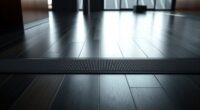To control dust before scrubbing, start by turning on or upgrading your air purifiers with HEPA filters to capture airborne particles. Wear PPE like a well-fitting N95 mask, gloves, and goggles to protect yourself from irritants. Use long sleeves and pants to create a physical barrier against dust settling on your skin. Keep dust containment in mind and combine filtration with protective gear for thorough safety. For a step-by-step approach, continue to explore effective dust management tips.
Key Takeaways
- Turn on or upgrade air purifiers with HEPA filters to capture airborne dust before scrubbing.
- Wear PPE such as masks, gloves, and goggles to prevent dust inhalation and contact during cleaning.
- Use dust barriers or coverings to contain dust in specific areas and prevent its dispersal.
- Moisten surfaces with a damp cloth or mop to reduce dust particles becoming airborne.
- Minimize movement and disturbance of dust-prone areas prior to scrubbing to prevent dispersal.

Dust can quickly become a nuisance and pose health risks if not managed properly. Before you start scrubbing or cleaning, it’s vital to take steps that minimize dust dispersal and protect your health. One of the most effective ways to do this is by investing in proper air filtration. Using high-efficiency particulate air (HEPA) filters can markedly reduce airborne dust particles, improving indoor air quality and making your cleaning efforts safer. Turn on your air purifier or upgrade your existing filtration system to guarantee it captures even the tiniest dust particles. This not only prevents dust from settling on surfaces but also keeps you from inhaling harmful particles during the cleaning process. Incorporating evidence-based insights into your cleaning routine ensures your efforts are both effective and safe.
Equally important is wearing personal protective equipment (PPE). This includes a well-fitting mask, such as an N95 respirator, to block inhalation of airborne dust. Gloves and goggles can protect your skin and eyes from dust contact, especially if you’re dealing with construction debris or thick layers of dust. PPE acts as a barrier, reducing your exposure to irritants and potential allergens. Don’t overlook the importance of proper clothing—long sleeves and pants can prevent dust from settling on your skin, further reducing contact. Remember, the goal is to create a barrier between you and the dust to keep airborne particles at bay, especially before you start scrubbing or other intense cleaning activities.
Frequently Asked Questions
What Are the Best Dust Control Products for Industrial Settings?
You should consider using dust suppression methods like water sprays, wetting agents, or fogging systems for industrial dust control. These products effectively reduce airborne dust, improving safety and air quality. For heavy-duty environments, industrial dust control products such as misting systems and dust suppressants work best. Always evaluate your specific needs, and choose solutions that match your worksite’s dust levels to guarantee ideal control and compliance with safety standards.
How Often Should Dust Control Measures Be Maintained?
You should maintain dust control measures regularly, following a set maintenance schedule based on your facility’s dust levels and equipment. Effectiveness monitoring is essential—inspect and test dust controls frequently to guarantee they work properly. Adjust your maintenance routine as needed, especially after equipment upgrades or changes in dust production. Consistent upkeep keeps dust levels low, protects worker health, and maintains compliance with safety standards.
Are There Environmentally Friendly Dust Suppression Options?
Yes, there are eco-friendly methods for dust suppression. You can use biodegradable solutions like plant-based oils or natural binders that effectively control dust without harming the environment. These options are safe, sustainable, and reduce chemical runoff. By choosing eco-friendly methods, you help protect ecosystems while maintaining a clean, dust-free environment. Always look for products labeled as biodegradable and environmentally safe to guarantee you’re making responsible choices.
How Can I Prevent Dust From Becoming Airborne During Cleaning?
Prevent dust from becoming airborne during cleaning like catching butterflies before they fly away. You should use air filtration systems to trap dust particles effectively. Wearing personal protective equipment, such as masks and goggles, keeps dust from reaching your face and lungs. Dampen surfaces before cleaning to reduce dust dispersal. These steps help maintain a safer environment, ensuring you control dust efficiently and prevent it from spreading during your cleaning process.
What Safety Precautions Are Needed When Applying Dust Control Chemicals?
When applying dust control chemicals, you should always wear appropriate personal protective equipment like gloves, goggles, and masks to safeguard yourself. Follow proper chemical handling procedures by reading labels carefully, mixing chemicals in well-ventilated areas, and avoiding ingestion or skin contact. Make certain you’re trained on the safe use of these products, and keep emergency equipment nearby in case of accidental spills or exposure.
Conclusion
Controlling dust before scrubbing is essential for a safer, cleaner environment. By using damp cloths and proper ventilation, you reduce airborne particles effectively. Did you know that workplaces with good dust control see a 30% decrease in respiratory issues? Taking these simple steps not only improves air quality but also protects your health. So, stay proactive, keep dust in check, and enjoy a healthier space every day.









